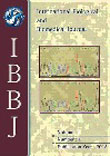فهرست مطالب

International Biological and Biomedical Journal
Volume:1 Issue: 4, Autumn 2015
- تاریخ انتشار: 1394/12/17
- تعداد عناوین: 6
-
Pages 128-136The epigenetic alterations like histone modifications , DNA methylation and others remarkable categories including nucleosome remodeling and RNA mediated targeting have been strongly investigated recently .In this way , beside the notable importance of DNA methylation ,the histone modifications are the most important issues in the tumorogenesis and cancer progression. Moreover, the fluctuations of histone modifications particularly, the dysregulation of histone alterations is engaged directly in carcinogenesis. Conclusively, it is confirmed that aberrant epigenetic modifications along side with chromosomal losses and mutations are involved in cancer progression. Hence, histone modifications and DNA methylation have the impressive abilities and potential to be practical prognostic biomarkers in order to manage all aspects of cancers like diagnosis, controlling and treatment. In this review article, we focus the recent advances of these alterations specially, histone modifications in gastric cancer development.Keywords: Histone modifications, gastric cancer, DNA methylation, epigenetic
-
Pages 137-145Osteoporosis is a major public health problem. Menopause provokes a decrease in bone mineral density (BMD) that causes postmenopausal osteoporosis. This study aimed to compare different regions for BMD measurement in postmenopausal women, with regarding to the effect of age, weight and height. 313 osteoporotic menopaused women were classified in 1 of 3 categories on the basis of their age (50-55, 56-60, and 61-65 years old), weight (under 51, 51-60, 61-70, 71-80, and more than 80 Kg), height (till 145, 146-150, 151-155, 156-160, and higher than 160 cm). BMD was evaluated based on T-score and percentage of BMD. Data are presented on those regions of the femur (right femoral, left femoral, right total neck, and left total) neck and lumbar (L1L4) spine. In comparison between lumbar spine and femur, the lumbar spine region had more significant effects on BMD measurement in menopaused old women regarding to the age, weight and height division. Also, the neck region of the femur region was more important than the total neck region. In the neck region, neck left T-score was more efficient than neck right. These were stable in all age, weight, and height classifications after menopause. So, age, weight, and height of women older than 50 years that are menopaused, are not effecting on calcification of important BMD measurement regions.Keywords: Postmenopausal osteoporosis, bone mineral density, age, weigth, height
-
Pages 146-156Grasses are natural homogenous group of plants and belong to the Gramineae family (Poaceae). The value of grasses to mankind has been recognized since the dawn of human civilization and culture of cereal grasses. In the present study, Leptochloa uniflora Hochst (Poaceae) was subjected to antioxidant and phytochemical profiles using UV-Vis, FTIR and HPTLC. Antioxidant assays were studied using DPPH, phosphomolybdenum and H2O2 scavenging activity. Antioxidant activities on L. uniflora showed efficient radical scavenging effects. Phytochemical profiles determined the presence of various bioactive compounds. It is hoped that the present work revealed the utility of L. uniflora plant extracts for field applications.Keywords: PhytochemicaL, Antioxidant, HPTLC
-
Pages 157-159In the present study the rural population of Vijayawada was selected and 243 fasting blood samples were collected from the male and female patients who were suffering with one or more clinical symptoms of heart problem. The patients were analyzed for serum lipid profile i.e. Total Cholesterol, HDLCholesterol, Triglyceride (Tg), LDL-Cholesterol and VLDL-Cholesterol. The people were categorized according to their gender and age. The overall male patients were 146 and females were 97 in number. These people were separated by age groups like 61 years (male: 29, female: 11). The lipid profile significantly varied in the age group of 41-60 years in male and female patients where as there was no significant difference in the reaming age groups. A slight variation was observed between males and females within different age groups. Ultimately the 41-60 years age group showed the risk factors.Keywords: Lipid profile, Age groups, Risk factor, Gender
-
Pages 160-163Infective endocarditis can complicate with ischemic stroke. Neurological complications develop in 20-40% of all patients with infective endocarditis. These are mainly due to vegetation embolism.This report represents a case of 30 years old female patient who presented with features of heart failure New York Heart Association (NYHA) class IV with infective endocarditis and left hemiparesis. On examination at admission, she was conscious, afebrile, orthopneic, tachypneic, had warm extremities, tinge of jaundice, finger and toe clubbing grade 4, and moderate pretibial edema. Her blood pressure was 107/54 mm Hg and had heart rate of 125 beats per minute. She had cardiomegaly with apex shifted to 6th intercostal space, soft s1 loud p2 and apical pansystolic murmur grade 3 radiating to axilla of MR, pansystolic murmur left lower sternal border of TR and early diastolic murmur of AR. There was mild ascites, hepatosplenomegaly, fine bilateral bibasal crepitations and left hemiparesis. Echocardiogram showed severe mitral regurgitation, moderate aortic regurgitation and multiple vegetations. This case is presented to assert the importance of early diagnosis of infective endocarditis to prevent the occurrence of neurological sequelae. The rapid diagnosis using Dukes criteria of infective endocarditis is of paramount importance to prevent or reduce neurological sequelae. This patient had findings of splenomegaly and clubbing suggesting long standing endocarditis that could have been identified early.Keywords: Infective endocarditis, stroke, neurological complications
-
Pages 164-166Beta thalassemia is the most common autosomal recessive disorder. The present study reports a rare β globin gene mutation, HBB: c.180G>A: codon 59 (AAG/AAA), in a patient from Gilan province, northern Iran. Nucleotide sequencing of amplified DNA belonging to a 35 years old man presenting mild hypochromia revealed a synonymous mutation due to a G>A conversion at the third position of codon 59 of the beta globin gene. The haplotype combination of 2 restriction enzyme sites in beta globin cluster was determined for this mutation. To our knowledge, this is the first article reporting a synonymous mutation at codon 59 (G>A) among the Iranian population highlighting once again the high heterogeneity of this population.Keywords: Beta globin, HBB: c.180G>A mutation, Iran

